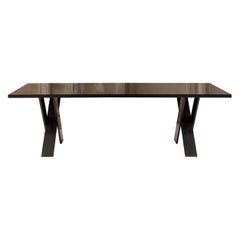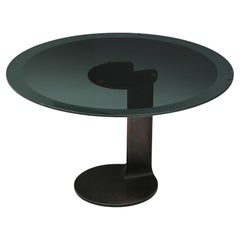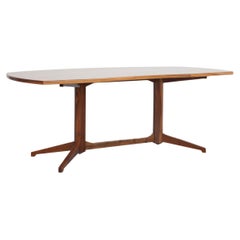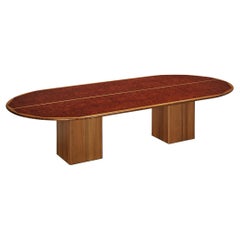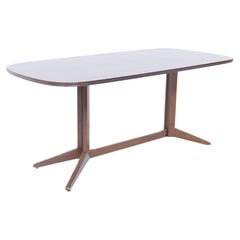Poggi Tables
5
to
5
5
5
5
4
5
3
2
3
2
Height
to
Width
to
Depth
to
4
4
1
1
1
5
5
42
413
176
150
144
Creator: Poggi
Franco Albini for Poggi Dining Table in Walnut
By Franco Albini, Poggi
Located in Waalwijk, NL
Franco Albini for Poggi, dining table, model TL2, walnut and iron, Italy, 1951.
The TL2 table by Franco Albini features a simplistic and sleek design. Executed in darkened walnut wo...
Category
1950s Italian Mid-Century Modern Vintage Poggi Tables
Materials
Iron
Midcentury Italian table mod. TL 58 by Marco Zanuso for Poggi
By Poggi, Marco Zanuso
Located in Piacenza, Italy
Midcentury table model TL 58 designed by Marco Zanuso for Poggi
Italy, 1970
Bibl.: Giuliana Gramigna Repertorio del Design Italiano1950-2000 Allemandi 2011 pag. 224
Category
1970s Italian Mid-Century Modern Vintage Poggi Tables
Materials
Wood
TL59 Dining Table in Bronze & Glass by Afra & Tobia Scarpa for Poggi, 1975
By Poggi, Afra & Tobia Scarpa
Located in Antwerp, BE
TL59; dining table; round; bronze; glass; Smoked glass; Afra & Tobia Scarpa; Poggi; 1975; Italy; Italian Design; Post-Modern;
This remarkable round dining table is designed by A...
Category
1970s Italian Post-Modern Vintage Poggi Tables
Materials
Bronze, Metal
Franco Albini TL30 Round Table in Metal and Wood for Poggi Pavia 1950s Italy
By Franco Albini, Poggi
Located in Montecatini Terme, IT
Round table model TL30 with black lacquered metal base and a wooden top.
Designed by Franco Albini for Poggi, Pavia in 1950s.
After spending his childhood and part of his youth in Robbiate in Brianza, where he was born in 1905, Franco Albini moved with his family to Milan. Here he enrolled in the Faculty of Architecture of the Polytechnic and graduated in 1929. He starts his professional activity in the studio of Gio Ponti and Emilio Lancia, with whom he collaborates for three years. He probably had his first international contacts here
In those three years, the works carried out are admittedly of a twentieth-century imprint. It was the meeting with Edoardo Persico that marked a clear turning point towards rationalism and the rapprochement with the group of editors of “Casabella”.
The new phase that that meeting provoked starts with the opening of the first professional studio in via Panizza with Renato Camus and Giancarlo Palanti. The group of architects began to deal with public housing by participating in the competition for the Baracca neighborhood in San Siro in 1932 and then creating the Ifacp neighborhoods: Fabio Filzi (1936/38), Gabriele D’Annunzio and Ettore Ponti (1939).
Also in those years Albini worked on his first villa Pestarini.
But it is above all in the context of the exhibitions that the Milanese master experiments his compromise between that “rigor and poetic fantasy” coining the elements that will be a recurring theme in all the declinations of his work – architecture, interiors, design pieces . The opening in 1933 of the new headquarters of the Triennale in Milan, in the Palazzo dell’Arte, becomes an important opportunity to express the strong innovative character of rationalist thought, a gym in which to freely experiment with new materials and new solutions, but above all a “method”.
Together with Giancarlo Palanti, Albini on the occasion of the V Triennale di Milano sets up the steel structure house, for which he also designs the ‘furniture. At the subsequent Triennale of 1936, marked by the untimely death of Persico, together with a group of young designers gathered by Pagano in the previous edition of 1933, Franco Albini takes care of the preparation of the exhibition of the house, in which the furniture of three types of accommodation. The staging of Stanza per un uomo, at that same Triennale, allows us to understand the acute and ironic approach that is part of Albini, as a man and as a designer: the theme addressed is that of the existenzminimum and the reference of the project is to the fascist myth of the athletic and sporty man, but it is also a way to reflect on low-cost housing, the reduction of surfaces to a minimum and respect for the way of living.
In that same year Albini and Romano designed the Ancient Italian Goldsmith’s Exhibition: vertical uprights, simple linear rods, design the space. A theme, that of the “flagpole”, which seems to be the center of the evolution of his production and creative process. The concept is reworked over time, with the technique of decomposition and recomposition typical of Albinian planning: in the setting up of the Scipio Exhibition and of contemporary drawings (1941) the tapered flagpoles, on which the paintings and display cases are hung, are supported by a grid of steel cables; in the Vanzetti stand (1942) they take on the V shape; in the Olivetti store in Paris (1956) the uprights in polished mahogany support the shelves for displaying typewriters and calculators. The reflection on this theme arises from the desire to interpret the architectural space, to read it through the use of a grid, to introduce the third dimension, the vertical one, while maintaining a sense of lightness and transparency.
The flagpole is found, however, also in areas other than the exhibition ones. In the apartments he designed, it is used as a pivot on which the paintings can be suspended and rotated to allow different points of view, but at the same time as an element capable of dividing spaces. The Veliero bookcase...
Category
1950s Italian Mid-Century Modern Vintage Poggi Tables
Materials
Metal
Rare Mahogany 'TL2' Cavalletto Table / Desk by Franco Albini for Poggi, Italy
By Franco Albini, Poggi
Located in London, GB
A rare mahogany version of the Cavaletto or TL2 table designed by the great neo-rationalist designer, Franco Albini. Designed in 1950 for manufacturers Poggi...
Category
1950s Italian Mid-Century Modern Vintage Poggi Tables
Materials
Steel
Related Items
Desk Model TL22, by Franco Albini and Franca Helg. Poggi, 1958
By Amando Poggi, Franco Albini and Franca Helg
Located in Wolfurt, AT
Desk model TL22, designed by Franco Albini and Franca Helg and manufactured by Poggi in 1958.
Table completely restored. Wood: walnut.
Letteratura: Gramigna G., Repertorio del desig...
Category
1950s Italian Mid-Century Modern Vintage Poggi Tables
Materials
Walnut
Afra & Tobia Scarpa for Maxalto 'Artona' Large Dining Table
By Maxalto, Afra & Tobia Scarpa
Located in Waalwijk, NL
Afra & Tobia Scarpa for Maxalto, large oval dining table model ‘Artona’, walnut, walnut burl, ebony, brass, Italy, 1975/1979
Intriguing table designed by Afra and Tobia Scarpa. On t...
Category
1970s Italian Post-Modern Vintage Poggi Tables
Materials
Brass
Tobia & Afra Scarpa Africa Table
By Afra & Tobia Scarpa
Located in BANGALOW, NSW
The ‘Africa’ or 'Artona' table was designed by Tobia & Afra Scarpa in the 1975.
This table is of historical significance, being a part of the very first design series to come from M...
Category
Mid-20th Century Italian Mid-Century Modern Poggi Tables
Materials
Walnut
Franco Albini Rosewood Mid-Century Modern “LB7” Modular Bookcase for Poggi, 1957
By Poggi, Franco Albini
Located in Vicenza, IT
LB7 bookcase, designed by Franco Albini and manufactured by Poggi in 1957.
Modular bookstore composed by upholds, containers with flying and doors, shelve. The industrial standard for every product component allows permanent and different solutions, from the bearing structures to the elements. The structure does not need anchorages to the wall and can be placed in the middle of the space.
This set is composed of 3 modules, ten shelves, and three containers.
It is made of Rosewood, iron, and brass.
Excellent vintage condition.
Franco Albini was born in Robbiate in 1905, and after his childhood and part of his youth, he moved to Milan.
He graduated at Politecnico of Milan, Faculty of Architecture, in 1929, and He collaborated for three years in Giò Ponti and Emilio Lancia’s office. He probably had his international contacts here, at The International Exposition of 1929 in Barcelona and Paris, where he visited le Corbusier’s office, as Franca Helg used to tell.
Throughout these first three years, his works were undoubtedly related to XIXth Century. His meeting with Edoardo Persico marks an evident turnover towards rationalism and writers for “Casabella” magazine. Persico’s thoughtful and ironical comments on some of Albini’s drawings for office furniture caused him deep upsetting. “I spent days of real anxiety – tells Albini – I had to answer all questions. I had a long fever”.
The new phase that the meeting provoked begins with opening his own first office at Via Panizza with Renato Camus and Giancarlo Palanti. The group of Architects starts taking care of social housing, participating in the competition for the Baracca neighborhood in 1932, and then realizing the Ifacp neighborhood: Fabio Filzi (1936/38), Gabriele D’Annunzio, and Ettore Ponti (1939).
During those years, He also worked for his first private villa (Pestarini).
It is mainly in the context of exhibitions that the Italian architect experiments the compromise between rigor and poetic fantasy that Pagano was talking about; He conceived all the elements that would become recurrent in all types of his work – Architecture, Interiors, Design. The 1933 opening of the new Triennale of Milano, in Palazzo dell’Arte, becomes an occasion to express the highly innovative character of rationalist thinking. In this place, to experiment with new materials and solutions, but most of all a “method”.
Young rationalist architects cultivated the art of exhibiting as a communication lab, an open field to space solutions.
Albini, with Giancarlo Palanti, sets the steel structure house (with R. Camus, G. Mazzoleni, G. Minoletti and coordination by G. Pagano) designing also its furniture. For the next Triennale in 1936, marked by Persico’s early death, Franco Albini, together with a group of young architects around Pagano, takes care of the exhibition of Dwelling, where he presented 3 types of lodgings.
In the same year, Albini and Romano design the exhibition for Ancient Italian jewelry: vertical uprights, simple linear poles design space. This element is recurring in other works, like the Scipione exhibition (1941), Vanzetti stand (1942), and Olivetti shop in Paris (1956). The architectural space is readable through a grid, introducing a third dimension, the vertical one, with a sense of lightness and transparency.
Upright is also used in design objects, such as the Veliero bookcase...
Category
1950s Italian Mid-Century Modern Vintage Poggi Tables
Materials
Brass, Iron
H 109.45 in W 104.34 in D 13.78 in
Afra & Tobia Scarpa Table with Oval Shaped Top in Wood by Maxalto 1970s
By Maxalto, Afra & Tobia Scarpa
Located in Montecatini Terme, IT
Oval-shape table from Artona series in wood with brass details, designed by Tobia and Afra Scarpa produced by Maxalto, 1970s.
Tobia Scarpa and his wife Afra Bianchin began their lon...
Category
1970s Italian Post-Modern Vintage Poggi Tables
Materials
Brass
Wood Dining Table, Afra & Tobia Scarpa for Cassina, Italy 1980s
By Cassina, Afra & Tobia Scarpa
Located in Ceglie Messapica, IT
Vintage Wood Dining Table, Afra & Tobia Scarpa for Cassina, Italy 1980s
A rare design dining table designed by Afra & Tobia Scarpa for Cassin...
Category
1980s European Mid-Century Modern Vintage Poggi Tables
Materials
Cherry
Afra e Tobia Scarpa Artona dining table Maxalto Italy 1975
By Afra & Tobia Scarpa
Located in Roosendaal, Noord Brabant
Beautiful Artona dining table designed by Afra e Tobia Scarpa and manufatcured by Maxalto in Italy in 1975. Elegant table with a round warm brown walnut wooden top with a black finis...
Category
1970s Italian Mid-Century Modern Vintage Poggi Tables
Materials
Concrete, Brass
Mid-Century Modern Italian Chrome and Glass Table Model "Marcuso" 2532 by Zanuso
By Marco Zanuso, Zanotta
Located in Prato, IT
Mid-Century Modern Italian chrome base and smoked glass top table model "Marcuso 2532" by Marco Zanuso for Zanotta, 1970s.
Category
1970s Italian Mid-Century Modern Vintage Poggi Tables
Materials
Chrome
H 28.35 in Dm 49.22 in
Low Center Table by Marco Zanuso
By Marco Zanuso, Zanotta
Located in Dronten, NL
Glass center or coffee table "Marcuso", designed by Marco Zanuso with smoked glass top and detachable stainless steel legs.
Rare round version with 3 legs.
Category
1970s Italian Mid-Century Modern Vintage Poggi Tables
Materials
Stainless Steel
Afra e Tobia Scarpa Tobio dining table B&B Italia 1974
By Afra & Tobia Scarpa
Located in Roosendaal, Noord Brabant
Iconinc 'Tobio' dining table designed by Afra e Tobia Scarpa and manufactured by B&B Italia. A true heritage piece that seamlessly blends timeless materials for a stunning aesthetic....
Category
1970s Italian Mid-Century Modern Vintage Poggi Tables
Materials
Marble
Italian Midcentury "Mou" Dining Table by Afra and Tobia Scarpa, 1970
By Afra & Tobia Scarpa, Molteni & C
Located in Traversetolo, IT
The Mou table, designed by Afra and Tobia Scarpa for Molteni, is an elegant and versatile creation of Italian design. Crafted with a precious solid rosewood veneered and bordered top...
Category
1960s Italian Mid-Century Modern Vintage Poggi Tables
Materials
Rosewood
H 28.75 in W 100.4 in D 37.41 in
Round Africa Table by Afra & Tobia Scarpa for Maxalto, 1975
By Maxalto, Afra & Tobia Scarpa
Located in Lasne, BE
Round wooden table by Tobia and Afra Scarpa. Stamped concrete block inside the table for stability. Wear due to time and age of the table.
Category
1970s Italian Mid-Century Modern Vintage Poggi Tables
Materials
Concrete
Previously Available Items
Marco Zanuso for Poggi Dining Table in Walnut
By Marco Zanuso, Poggi
Located in Waalwijk, NL
Marco Zanuso for Poggi, 'TL58' dining table, walnut, Italy, 1974
This dining table is manufactured by Poggi in the 1974. It features crossed, double legs that give the table an ar...
Category
1970s Italian Post-Modern Vintage Poggi Tables
Materials
Walnut
Vintage Wooden Table Att. to Franco Albini for Poggi
By Franco Albini, Poggi
Located in Milano, IT
The vintage wooden table attributed to the designer Franco Albini. It has been made by fine Italian manufacturer Poggi in the 1950s. The table has...
Category
1950s Italian Mid-Century Modern Vintage Poggi Tables
Materials
Wood
Table Designed by Franco Albini, Model Tl-22 Produced by Poggi, Italy 1958 ca.
By Franco Albini and Franca Helg, Poggi
Located in Piacenza, Italy
Walnut Table designed by Franco Albini and Franca Helg, Model TL-22 produced by Poggi, Italy 1958 ca.
Beautiful desk or table with boat shape.
Category
1950s Italian Mid-Century Modern Vintage Poggi Tables
Materials
Wood, Walnut
H 29.14 in W 76.38 in D 37.8 in
Franco Albini Poggi Wood Steel Desk Mod. Stadera Italy 1958 Excellent Patina
By Poggi, Franco Albini
Located in Catania, IT
This Stadera desk/table designed by Franco Albini was manufactured by Poggi in Italy in 1958.
This desk is in teak wood and has two side-by-side trapezoi...
Category
1950s Italian Mid-Century Modern Vintage Poggi Tables
Materials
Steel
H 28.75 in W 56.3 in D 32.68 in
Franco Albini and Franca Helg for Poggi Italian Dark Wood Dining Table TL22
By Franco Albini and Franca Helg, Poggi
Located in Reggio Emilia, IT
Italian Mid-Century Modern design dining table designed by Franco Albini and Franca Helg and produced by Poggi Pavia from 1958 with veneered dark wood top with elliptical shaped long...
Category
1950s Italian Mid-Century Modern Vintage Poggi Tables
Materials
Wood
H 28.94 in W 77.17 in D 44.3 in
Franco Albini and Franca Helg Table TL22 Wood Poggi, Italy, circa 1958
By Franco Albini and Franca Helg, Poggi
Located in Milan, IT
The TL22 is a table designed by Franco Albini and Franca Helg to have a cohesive and harmonious structural dimension. The table, exclusively in wood, is formed by a well-proportioned...
Category
Mid-20th Century Italian Mid-Century Modern Poggi Tables
Materials
Wood
H 28.35 in W 82.68 in D 51.19 in
Poggi tables for sale on 1stDibs.
Poggi tables are available for sale on 1stDibs. These distinctive items are frequently made of metal and are designed with extraordinary care. There are many options to choose from in our collection of Poggi tables, although brown editions of this piece are particularly popular. Many of the original tables by Poggi were created in the mid-century modern style in italy during the 20th century. If you’re looking for additional options, many customers also consider tables by Poltronova, Silvio Coppola, and Sormani. Prices for Poggi tables can differ depending upon size, time period and other attributes — on 1stDibs, these items begin at $3,141 and can go as high as $12,632, while a piece like these, on average, fetch $8,350.

